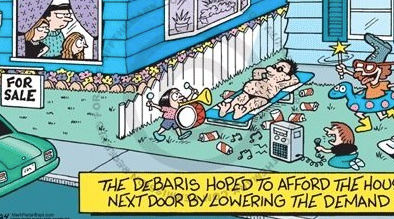By David Swedelson, Condo Lawyer and HOA Attorney; Senior Partner at SwedelsonGottlieb, Community Association Attorneys

Every condo or homeowners association has one, that one owner that does not follow the rules, violates the CC&Rs, creates a nuisance or worse. The “bad” owner, the one that does not belong in a deed restricted community. And we often hear complaints from other owners suggesting that the bad neighbor is bringing down property values at their association. Turns out they may be right. According to a recent article in the New York Times regarding a neighbor’s effect on appraisals, “[w]hen calculating the value of a property, an appraiser also factors in surrounding conditions. Neighborhood nuisances, like an overgrown yard or a persistent odor, could in some cases bring down the value of adjacent homes by 5-10%…”
The article, follow this link, indicated that what we might think of as a bad neighbor, “the appraisal industry calls internally ‘external obsolescence’- depreciation caused by factors off the property and beyond the homeowner’s control.”
The article points out that “there are a number of different things that could be going on from a nasty, cranky neighbor to a sloppy neighbor, to lots of barking dogs…”
Many of these conditions are also violations of many community associations’ governing documents. It is the responsibility of a community association to address violations that impact the neighbors’ value of their property. The failure to address the issue could result in a lawsuit by an owner that’s selling their home, claiming damages for the decreased value of their property as a result of the bad neighbor. The article references community associations and quotes a New York real estate lawyer who states, “in a co-op or condominium, house rules are likely to prohibit habits that interfere with a neighbor’s quiet enjoyment of their property.” He advises approaching a neighbor directly before making a complaint to a board. Not a bad idea.
But many owners are reluctant to confront their bad neighbor. And many bad neighbor situations do require association involvement, and boards of directors are encouraged to, at the minimum, evaluate the complaint and determine what actions can be taken, if appropriate, to address and eliminate any violations to the association’s governing documents. This could be a demand letter, a hearing with fines levied, a mediation offer or through a Request for Resolution pursuant to Civil Code Section 1369.520. Simply stated, California community associations cannot simply ignore the bad neighbor problem.
David Swedelson is a California community Association legal expert. He can be contacted via email: dcs@sghoalaw.com
 HOA Law Blog
HOA Law Blog


